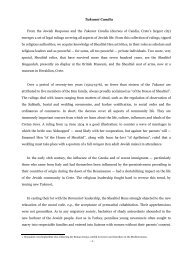a thesis by Flora Jane Satt - Shealtiel
a thesis by Flora Jane Satt - Shealtiel
a thesis by Flora Jane Satt - Shealtiel
Create successful ePaper yourself
Turn your PDF publications into a flip-book with our unique Google optimized e-Paper software.
<strong>Flora</strong> <strong>Jane</strong> <strong>Satt</strong>—annotated <strong>by</strong> Miles Saltielthe nature of the ores involved, all of which required much capitalequipment and complicated processes to refine. Saltiel’s experiencebusiness connections and vast wealth put him in a superiorposition in this respect.However he soon ran into other difficulties. With the discovery ofmuch richer lodes in southern Fremont County (Custer Countynow) labor supply became practically nonexistent in the Cotopaxiarea. Saltiel had always been reluctant to pay adequate wages, inrelation to neighboring mine owners. “Help-wanted ads” beganappearing in the Denver and eastern papers, but even his eloquencethere could not buck the competition of the simultaneousstrikes in Leadville, Rosita, and Western Slope camps. In addition,those who did not care for a miner’s life could take jobs with therailroads which were then also expanding at a prodigious rate.Saltiel’s ingenious solution to this seemingly insurmountableproblem was to import his own labor supply from Europe.Imported labour from EuropeThis is of the essence of the “fraud” claimbut on scrutiny turns out to straincredulity. <strong>Satt</strong> argues (here, p25, and p33)that Saltiel always intended the colony tofail so that the pioneers would be obligedto work his mine. The record confirmsthat the region suffered from a labourshortage at the time, with miners drawnto richer lodes to the south. But sointricate a scheme is far-fetched, arguingfor a degree of long-term planning hard tocredit given the unpredictability inherentin frontier conditions; and for a degree ofpatience implausible on the part ofemployers said to be crying out forlabour.The notion that Saltiel sought to engineera pool of captive labour unravels on aclose examination of the very accountsintended to support it. Roberts (op citp127-8) writes, “A few of the men wereable to obtain temporary employmentfrom the Saltiel mine”. This meagre takeupof the labour represented <strong>by</strong> thecolonists is inconsistent with a labourshortage so acute as to call for theprolonged timescale (see Appendix 2—Timeline) or Byzantine complexities ofSaltiel’s alleged plot. Nor is there anyevidence of compulsion. Tom Young,Cotopaxi’s historian, has confirmed thatthe colonists were free to work elsewhereand the record confirms that they did so,at neighbouring mines and on therailroad.A formerly overlooked contemporaneoussource demolishes the “sweated labour”<strong>thesis</strong> once and for all. In a documentdated October 1882, the self-styledGeneral Manager of the colony, JuliusSchwarz, (whom <strong>Satt</strong> characterises asSaltiel’s partner) wrote that he hadarranged work at $2.00 per day from theDenver and Rio Grande Railroad for asmany colonists as wanted it(p13).Schwarz also records withoutembarrassment that the colonists hadalready worked in a mine, presumablySaltiel’s (also p13). This is at odds withthe narrative offered <strong>by</strong> <strong>Satt</strong>. She statesthat it was Saltiel’s hard–heartednesswhich obliged the settlers to accept workin his mine in the “the winter months”and that they then moved to the railroad.(<strong>Satt</strong>, p25). In sum, with scant evidence ofa pressing labour shortage at Saltiel’smine and the reverse of any evidence ofcoercion, we may recognise the “sweatedlabour” <strong>thesis</strong> as a fallacy. SeeAppendix 1—A note on Sources andAppendix 3—Allegations.The material in the sidebar, Schwarz’report on p17 strongly supports my longstandingsurmise—whatever the howls ofoutrage from those who grew up on thetradition of Saltiel’s villainy—that heplanned an act of high-profilebenefaction.It is far more of a piece with the traditionsof Jewish business conduct that aprosperous entrepreneur at the heart ofthe local Jewish community should seekprestige from public works than that heshould court public obloquy <strong>by</strong> abusinghis coreligionists above a townshipformerly bearing his name. On this view,the collapse should be seen as the reverseof Saltiel’s intentions. After all, it affordedhim no profit; embarrassed him with hisneighbours in Cotopaxi and Denver;made for complications with HEAShowever amicably resolved; and has givenhim a reputation for villainy unchallengeduntil the new evidence thrown up <strong>by</strong> the<strong>Shealtiel</strong>: A Famly Saga and therediscovery of Schwarz’ contemporaneousreportWith hindsight we can say that Saltiel hadhimself to blame for over-optimism inpromoting the scheme to HEAS and hemight have been more patient with thecolonists after their first summer. Withthat same hindsight, however, we can alsosay that there is nothing he could havedone: every such colony in the U.S.collapsed. See Appendix 3—Allegations, for an expansion on thesepoints.7








